#this is such useful advice
Explore tagged Tumblr posts
Text
actually yeah, this is not the place for it, but i wanna know
ABCDEFGHI KLMNOP RSTUVWXY
23/26
#and per se and#my stomach is weak so i use acetaminophen for headaches and. nothing for my usual pain#uh i'll get advice on that soob
6K notes
·
View notes
Text
i feel like people forget that sometimes characters in fic are written like that because it's a reflection of real life.
people have sex without setting boundaries. people have unprotected sex without talking about their sexual histories or producing recent sti tests. people play with kink without discussing it ahead of time or establishing a safeword. they have anal without 'enough' prep or lube—they may even prefer it like that.
and none of this is really a fantasy. it's all pretty normal. you can feel that it's inappropriately normalised, and you'd probably be right! but it is normalised: one study found that 58% of female undergraduate students on the campus studied had been choked during sex. 20% of those students said that they'd never been asked if it was ok; another 30% said they'd only sometimes been asked if they consented. fully half! (non-paywalled journal article on choking during sex here, including these numbers.) despite a rise in stis of all sorts, condom use is declining. (pdf link to the full text of this study about declining condom use in the us; aidsmap article about an australian study with similar results.)
even when people do talk about things—sex or anything else—they communicate imperfectly. 'yeah, but don't go too far' is consenting and setting a boundary, and also relying that the person you're talking to has the same metric for 'too far' that you do. for some people, 'the trash needs to go out' is a neutral, factual observation; for others, it's a request that the person they're speaking to take out the trash.
even when people understand each other perfectly, people react unpredictably to things sometimes! we behave irrationally! people laugh uncontrollably at funerals, or get angry at the straw that broke their back rather than the enormous load they were already carrying. they get scared and lash out at people trying to help them. when hurt, most people do not instinctively reach for therapy-approved grounding exercises and 'i feel' statements.
pretty much any bad choice that characters could conceivably make is a choice that people make in real life, on purpose, all the time. people do things that can have catastrophic, life-changing effects because it felt like a good idea at the time, or they're leaning into the vibe, or they just didn't think about it all that much, or an infinite number of other reasons.
fiction isn't intended as a guide on the best, safest, and most responsible ways to live your life, and fanfic isn't any different. it's not a narrative flaw to let characters do things that are messy or harmful or downright stupid—it's a reflection of what people are actually like, and not something that authors should feel they have to apologise for.
#fandom#fanfic#writing sex#writing#writing advice#i guess#i know no one is going to read this#but it just bums me the fuck out#people are messy and imperfect#it's part of what makes us interesting and fun tho#characters should be allowed to be messy and imperfect to#echoes linger
8K notes
·
View notes
Text

#i made this specifically about Duolingo because it pisses me off#me when i lay off a large amount of staff in favor of shitty ai but it's okay because i make funny tiktoks (i am a soulless corporation)#companies using shit like asmr or “girlies” in unmarked ads on social media#I hateeee you i hate you i hate you#every part of amusement had turned into advertisement#the legend of zelda#loz#tloz#ganondorf#good advice ganondorf#good advice
7K notes
·
View notes
Text
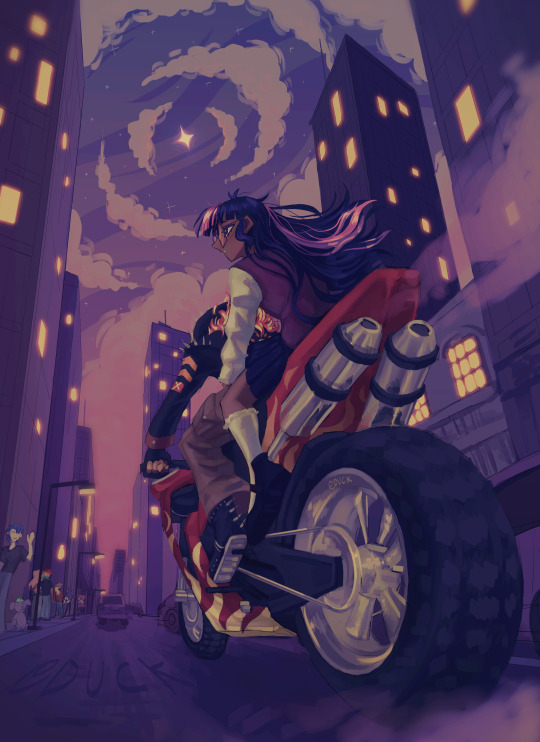
evening drive
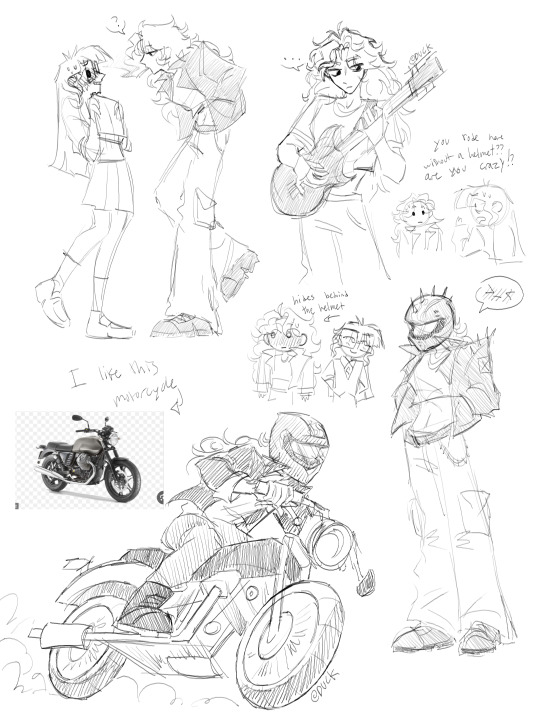
oh yes and some little doodles of them... sunset totally drives a motorcycle right?? been experimenting with how i want to draw her so maybe this'll stick idk.
#i use too much purple dont i#sciset#my art#mlp fim#mlp art#my little pony#mlp#twilight sparkle#eqg#mlp fanart#mlp eqg#equestria girls#scitwi#sci twi#mlp eg fanart#sunsetsparkle#sunset shimmer#ik the motorcycles dont match but i still havent figured out what i want hers to look like#aww lookit them they're both nerd weirdos#also thank you to the 12 different people i asked for advice when i was drawing this#3 point perspective is a pain in the.. back
5K notes
·
View notes
Text
Remember folks. No matter your thoughts on the matter, it's illegal to say "I want to kill the president of the United States." It's also illegal to say "I really, really think somebody should kill the president of the United States."
I'm just saying those phrases so everyone knows how illegal they are. You should probably spread this message, just so everybody else knows that you can not say "I want to kill the president of the United States."
3K notes
·
View notes
Text
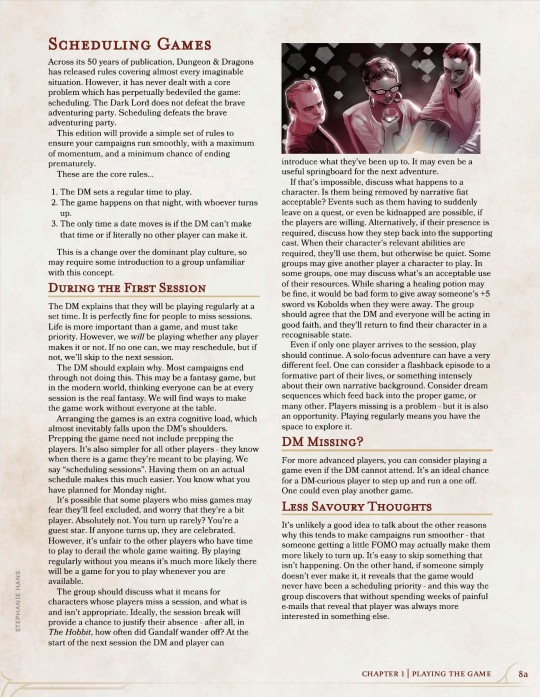
I was recently in a pub, talking to a friend about their collapsed game of Dungeons & Dragons. I was somewhat frustrated by their tale of woe – perhaps the most common tale of woe. I imagined all these decades of people wasting time, just waiting for that one player to be free on Friday.
I decided to solve their problem by writing a patch for the 2024 edition of the D&D Players handbook.
There's a PDF to download in the link
Print it out and slide it in after Page 8.
#dungeons and dragons#d&D#rpg#ttrpg#rpg advice#did kieron really walk into town to find a copy of D&D to check where this advice should go and then learn how to use the homebrew software#Just so he can give a little advice in a funny format?#Yes#Yes he did
2K notes
·
View notes
Note
Okay, but imagine Sir Galahad asking his father (Lancelot) for advice on dealing with his annoying companion who simply refuses to cooperate.
I can only imagine the "advice" he would give his son.
Lancelot is a warrior, not a tour guide.
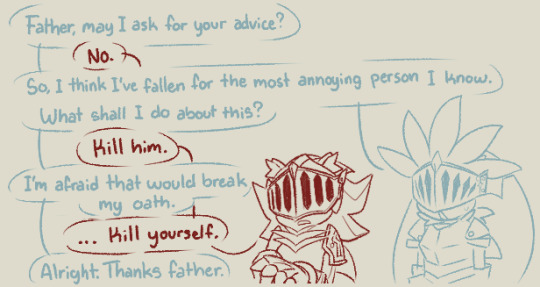
Y'know, maybe his one-size-fits-all solutions aren't always helpful
#sth#sth fanart#shadow the hedgehog#silver the hedgehog#satbk au#knights and poets au#roonies doodles#roonie answers#hes doing his best hes just giving the advice he'd use himself#in his mind he's nailing this father-son interaction#also shoutout to satbk for the semi-canon dadow its so based and also makes me laugh so hard#tw sui bait#<- just in case
2K notes
·
View notes
Text
Iranian state television on Tuesday afternoon urged people to remove WhatsApp from their smartphones, alleging without specific evidence that the messaging app gathered user information to send to Israel. In a statement, WhatsApp said it was “concerned these false reports will be an excuse for our services to be blocked at a time when people need them the most.” WhatsApp uses end-to-end encryption, meaning a service provider in the middle can’t read a message.
2K notes
·
View notes
Text
Let's Talk About Pacing Our Fight Scenes.
For Fast-Paced Parts:
Short words with single syllables. Immediately > at once/ endeavour > try/ indicate > point at/ investigate > check out.
Short sentences, the shorter the better.
Partial sentences to blaze through multiple senses and actions within a few lines.
Short paragraphs
Lots of verbs.
Few adjectives and adverbs.
Cut down on -ing form of verbs, as it can make words longer
Use simple past tense
Avoid conjunctions and link words.
Avoid internal thought - your characters are irrational, ruthless and in the flow of pure action.
For Slow-Paced Parts:
Use medium/long sentences
the paragraphs are longer: three lines minimum
Include longer words with more syllables
Use adjectives and maybe a couple of adverbs.
Insert the thoughts of the PoV character.
Words for Action Scenes
act, alter, attack, avert, back, block, bang, bash, battle, beat, beg, belt, bend, best, bite, blacken, bleed, blind, blister, blow, blunt, boil, bolt, boot, bore, bow, box, brace, brag, brash, brawl, break, breathe, brush, buck, bulgde, burn, burst, cackle, call, can, carry, cart, carve, catch, check, chop, chuck, clack, clank, clap, clash, claw, clear, cleave, click, cliff, cling, clip, close, club, cock, coil, cold, collar, come, con, connect, corner, cost, count, counter, cover, cower, crack, crackle, cram, crash, crawl, creep, crinkle, cross, crouch, rush, cry, cuff, cull, cup, curl, curse, curve, cusp, cut, dart, dash, deepen, dig, deep, dip, ditch, drive, drop, duck, dump, ede, effect, erect, escape, exert, expect, feint, fight, fire fist, fit, flag, flare, flash, flick, fling, flip, flock, force, gash, gasp, get, gore, grab, grasp, grip, grope, group, hack, harden, heat, help, hit, hop, hurl, hurry, impale, jab, jar, jerk, join, jolt, jump, keep, kick, kill, knee, knock, knot, knuckle, leak, leap, let, lever, lick, lift, lock, loop, lop, plunge, mask, nick, nip, open, oppose, pace, pack, pain, pair, pale, palm, pan, pant, parry, part, pass, paste, pat, peak, peck, pelt, pick, pierce, pile, ping, piss, pit, pivot, plot, pluck, plug, plunge, ply, point, pool, pop, pose, pot, pound, pour, powder, pray, preen, prepare, prey, prick, prickle, print, probe, pry, pull, pulp, pulse, pump, punch, pursue, push, quarry, quarter, quest, race, raise, rake, ram, rap, rasp, rear, retreat, rip, riposte, rivert, roar, rock, roll, rope, round, rouse, run, rush, sap, scale, scalp, scan, score,scream, seek, seep, shake, shape, sharpen, shock, shoot, shop, slap, slap, slash, slice, slick, slip, slit, smash, snap, snare, snatch, snipe, sock, space, spar, spark, speed, spike, spill, spin, spit, splash, spoil, spring, spur, spurt, spy, squirm, stand, steert, step, stick, strap, strike, stuff, suck, support, swat, sweat, sweep, swingm tack, tag, take, target, taste, team, tear, tent, test, thrash, throw, thrust, thud, tick, tide, tilt, time, tire, top, toss, tower, toy, trap, trick, trigger, trip, triumph, trouble, trump, try, tuck, tug, twril, twitch, weaken, wet, whip, whirl, whirr, whoop, whoosh, whop, work, zap, zip.
If you like my blog, buy me a coffee☕ and find me on instagram! 📸
#writing#writers and poets#writers on tumblr#creative writing#helping writers#writeblr#poets and writers#let's write#creative writers#resources for writers#writing practice#writing prompt#writing community#writing advice#writing ideas#on writing#writer#writing inspiration#writerscommunity#writer stuff#write me#write anything#write that down#write every day#write for us#writer community#writers#writers life#writers block#writers community
4K notes
·
View notes
Text
I have had these thoughts bubbling away in my head for like...eighteen months or so now (it will become very obvious why shortly) but the discussion in this post has pushed me to write them down: I think societally we HUGELY underestimate how motherhood for primary caregivers, particularly first-time motherhood, can be a source of vulnerability to radicalisation.
There is obviously huge cultural variance here, but for a lot of cis women becoming primary caregiver to an infant in a capitalist Western society represents a time of immense vulnerability because in general you are:
Incredibly sleep-deprived (which has well-documented knock-on effects for your judgement, mental health, etc)
If you gave birth, recovering from a significant challenge to your physical health (even in the best-case scenario)
Isolated from your previous networks and communities of people in full-time work
Completely separated from the context of your prior career goals and achievements
Under huge amounts of stress to learn how to care for an infant (don't get me started on breastfeeding)
And on top of this, you are also be experiencing a huge amount of messaging about how all this is natural, wonderful, something you're meant to do, something you should love doing, and something that you must do for the welfare of their child. It's a huge amount of pressure and life change even when everything goes right and there's very little cultural space to express negative feelings about it.
Any group of people who offer community, support, and affirmation to cis women in this situation are going to have a really good shot at radicalising them into some very weird and dangerous headspaces and in fact we see this happen all the time - think antivaxxers and TERFs. It flies under the radar because of the hazy positive glow that associates with motherhood and babies and also because we don't take the radicalisation of women seriously I guess because they rarely shoot anybody, but...yeah. It is such a vulnerable time!
#people who do not see themselves in the cishetero stereotype#are obviously going to have some separation from this & therefore protection#full confession: obviously in the last year and a half I have done a LOT of midnight Googling about Baby Things#and you know what. very often the top hits are Mumsnet forum threads#which...often contain useful and sympathetic advice#I can so easily see how people get sucked into that#they're not getting people with TERFy shit they're getting them with 'tips for getting your four month old to nap better'#which is the MOST IMPORTANT THING IN THE WORLD when your kid is four months old#and then the TERFy nonsense presumably comes later#because that's how radicalisation works
3K notes
·
View notes
Text

Two snakes, whispering in my ears
#I honestly wish AA4 took a different approach to the game#where we wouldn't put Kristoph in jail immediately but instead have him as a mentor figure through the game until the last case#and the entire game is Apollo having issues on who to trust#his employer who helped him set himself on the lawyer path?#or the man he used to admire now turned a shady guy giving unsolicited advice#ace attorney#phoenix wright#apollo justice#kristoph gavin#gyakuten saiban#naruhodo ryuichi#odoroki housuke#garyuu kirihito#apollo the poor child of divorce
1K notes
·
View notes
Text

#something zelda and especially us ganondorf fans need to remember tbh#the legend of zelda#loz#tloz#ganondorf#good advice ganondorf#good advice
2K notes
·
View notes
Text

#us politics#but also#life advice generally#I think I feel this in my bones precisely BECAUSE I struggle w despair#and I know how useless it is to have succumbed to it
1K notes
·
View notes
Text
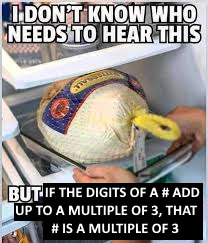
982 notes
·
View notes
Text










"It does come from real life, because I used to do live comedy and no one would be laughing but Lucia. I'd be like, 'It's fine.' Whether it's because she loves me or not." — Paul W. Downs (x)
HACKS: Season 4, Episode 4 "I Love LA"
#hacks#hacks spoilers#deborah vance#ava daniels#avadeb#hacks hbo#hacksedit#hboedit#femalegifsource#avadebedit#dailytvwomen#userbru#userclara#*#ava x deb#hacks404#she took carol burnetts advice in the gayest way possible#insane of paul to be like yeah this is just like when i used to try and make my wife laugh and didnt care about anyone else ...okay
866 notes
·
View notes